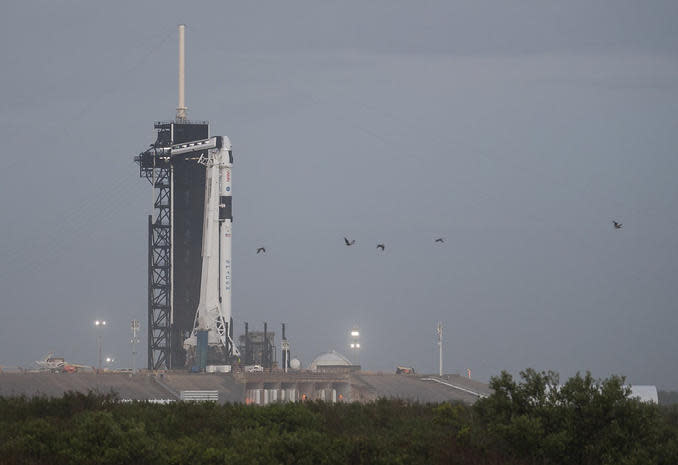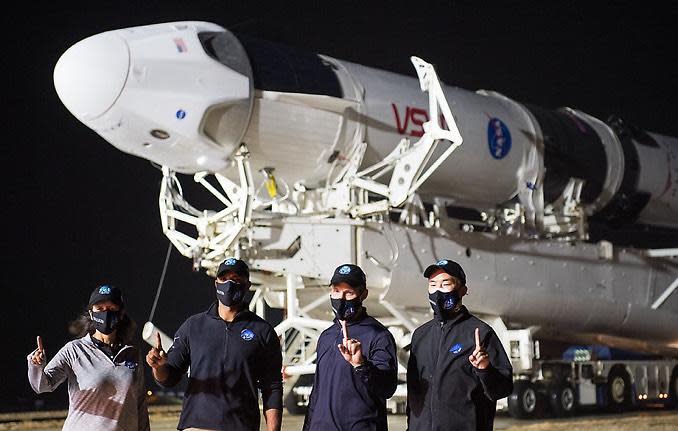SpaceX Crew Dragon cleared for weekend launch
NASA is planning to launch the SpaceX Crew Dragon spacecraft Sunday evening. Watch it live here. Our original story appears below.
NASA and SpaceX managers wrapped up a two-day flight readiness review Tuesday and tentatively cleared a Falcon 9 rocket and Crew Dragon capsule for launch Saturday, weather and last-minute repairs permitting, on a flight to ferry four astronauts to the International Space Station.
"This is a big day," said Kathy Lueders, director of space exploration at NASA Headquarters. "But the next few days are going to be big days, too, and we're going to have to be stepping carefully through our final readiness for the flight.
"This thorough review today, and everyone's approval to move forward, was a great first step towards flight."

Liftoff from historic pad 39A at the Kennedy Space Center is planned for 7:49 p.m. ET Saturday, with a backup opportunity available Sunday, at 7:27 p.m., if needed. The next opportunity after that is 6:16 p.m. Wednesday.
Assuming an on-time launch Saturday, Crew-1 commander Michael Hopkins, Victor Glover, Shannon Walker and Japanese astronaut Soichi Noguchi are expected to rendezvous and dock with the space station around 4:20 a.m. Sunday.
But the schedule is tight. Engineers plan to carry out a first stage engine test firing Wednesday after work to replace a component in the rocket's second stage and then carry out a detailed review to make sure the engines performed as required.
One of the nine first stage Merlin 1D engines had to be replaced and another was removed, serviced and re-installed in wake of an Oct. 2 Falcon 9 launch abort that grounded a U.S. Space Force Global Positioning System navigation satellite.
SpaceX originally planned to carry out the "static fire" engine test Monday, but high winds and rain forced a delay to Tuesday. Work to replace a component in the rocket's second stage then pushed the test to Wednesday.
"There's really nothing, no worries here about running out of time to do it," said Benji Reed, a senior Human Spaceflight Programs manager at SpaceX. "We still want to get static fire done, you know, relatively quickly so we can evaluate that data."
After the test firing, Hopkins and his crewmates plan to don their futuristic-looking spacesuits Thursday and strap into the Crew Dragon capsule atop pad 39A for a dress-rehearsal countdown. That same day, mission managers will hold a final launch readiness review to verify all systems are "go" for launch.
"Still looking at a launch right now on Saturday at 7:49 p.m. Eastern," said Steve Stich, manager of NASA's Commercial Crew Program. "The weather's looking good for that first opportunity on Saturday, and we have a backup, also, on Sunday. We're going to step through things very methodically."
Relatively good weather is required for launch at the Kennedy Space Center and in the Atlantic Ocean along a northeasterly trajectory from Cape Canaveral to Ireland where the Crew Dragon could be forced to splash down in a launch abort.
Generally calm seas also are needed for recovery of the Falcon 9's first stage on a SpaceX droneship stationed several hundred miles northeast of Cape Canaveral. Recovery is especially important this time around because SpaceX plans to use the booster for the next Crew Dragon launch in late March.

The long-awaited flight is the first operational use of a commercially developed SpaceX Crew Dragon capsule after an unpiloted test flight in 2019 and a piloted 64-day test flight earlier this year that carried astronauts Douglas Hurley and Robert Behnken to the International Space Station.
"Operational" in this context means the Crew Dragon is the first commercially developed spacecraft ever certified by NASA to carry astronauts to orbit. It's also the first U.S. spacecraft certified to remain in space for up to 210 days.
The Crew-1 astronauts plan to remain aloft for 197 days, eclipsing the 84-day U.S. record set by the final Skylab crew in 1974
NASA is counting on SpaceX's Crew Dragon, and eventually Boeing's CST-100 Starliner, to end the agency's sole reliance on Russian Soyuz spacecraft for carrying U.S., European, Japanese and Canadian astronauts to and from the space station.
NASA astronaut Kate Rubins used NASA's last currently contracted seat on a Russian spacecraft when she joined two Russian cosmonauts for launch aboard the Soyuz MS-17/63S spacecraft on October 14.
With the arrival of the Crew-1 astronauts, the station's expanded Expedition 64 crew will grow to seven. Four more astronauts will launch aboard the next Crew Dragon around March 30.
The next three-man Soyuz crew will arrive about 10 days later and Rubins, Sergey Ryzhikov and Sergey Kud-Sverchkov will return to Earth a week after that. The Crew-1 astronauts will follow suit around May 1 to wrap up a six-month flight.
Barack Obama on Trump: "This is not normal"

